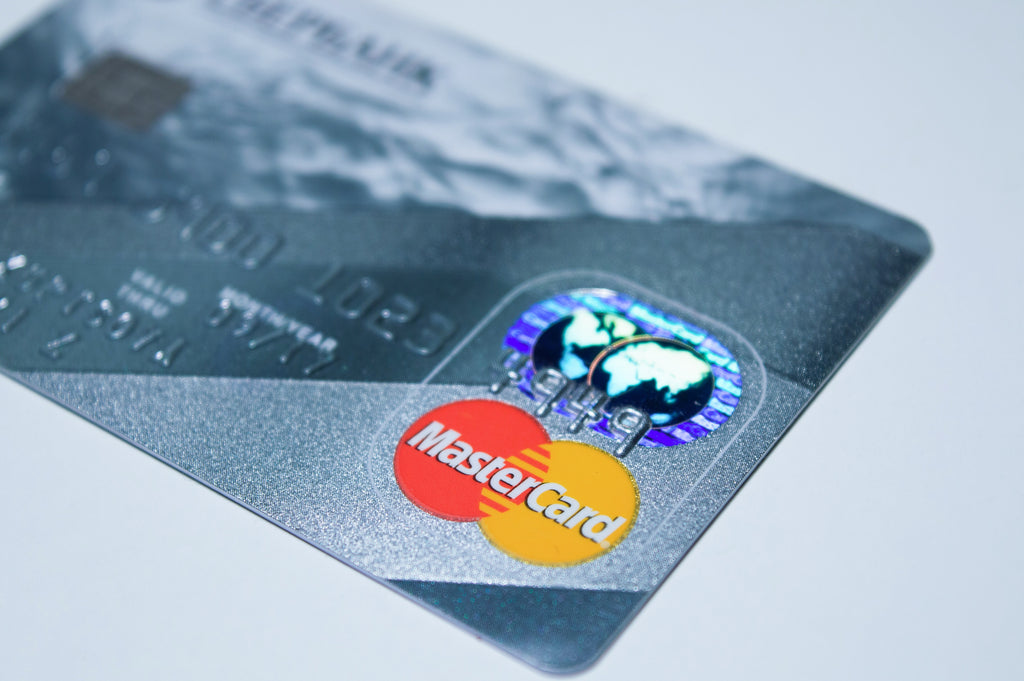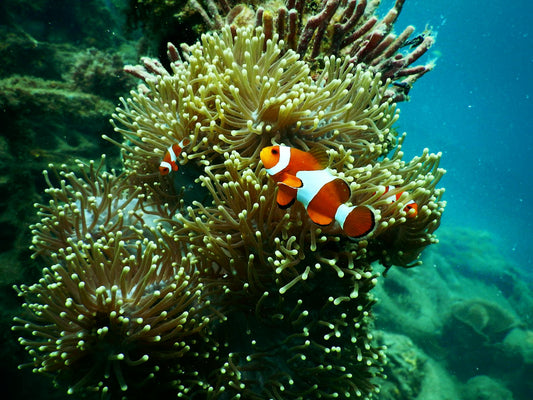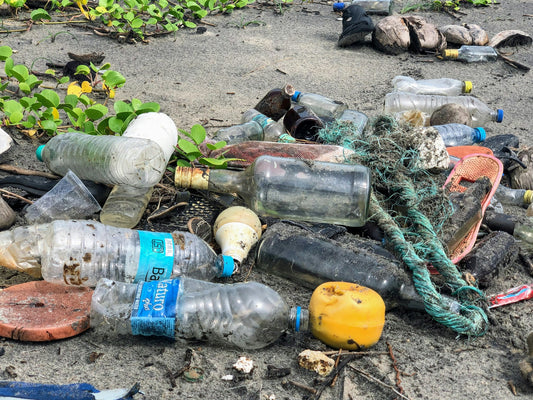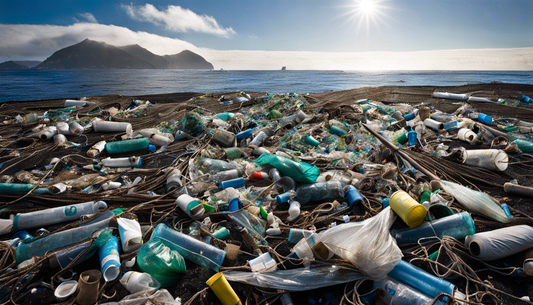Scientists call microplastics the number one threat to human kind!
Removing microplastics from the body is not easy. It requires commitment by limiting our exposure to help our bodies to heal naturally.
Learn more about the terrible impact of microplastics on our bodies in this article. We will also shine a light on the questions you ask yourself.
Where do they come from? How are we exposed to microplastics? And how can you help your body detoxify?
--------------------------
What are microplastics in the first place?
Microplastics, as the name implies are tiny plastic particles.
Officially, they are defined as less than five millimeters or 0.2 inches in diameter.
They either are intentionally produced or result from the breakdown of larger plastic items in nature.
Primary microplastics
Primary microplastics are intentionally produced for commercial use.
Examples are small particles in cosmetics or pellets for artificial grass. They also include shedding from microfiber production like fishing nets or clothes.
Primary microplastics enter the environment (and our bodies) through direct use or unintentionally. For instance, by swallowing toothpaste that contains microbeads.
Take Action Now!
Natural toothpaste tablets are an easy way to reduce the unintentional microplastics consumption in your life.
Secondary microplastics
Secondary microplastics result from littered larger plastic pieces that corrode over time.
Plastic never biodegrades. Over multiple years, decades of even centuries, it breaks down.
Littered plastic is exposed to weather conditions like sunlight, saltwater, wind, and sand. This sheds small plastic particles which then leak into nature.
Whether primary or secondary, microplastics are everywhere. You can find them on land and in oceans, lakes, and rivers.
In fact, 14 billion tons of microplastics are already in our oceans today. Microplastic makes 92% of the plastic found on ocean surfaces.
Marine animals die from the ingestion of microplastics every day. But while the plastic particles are a threat to animals, they are also very dangerous to humans.
Microplastics are often not filtered out during water treatment and enter the food chain. There, they pose a high risk of being consumed unintentionally.
The terrible impact of microplastics on our health
Researchers are still investigating how microplastics impact humans, but they've been making progress.
In recent years, more and more studies have surfaced with alarming evidence. These studies leave little doubt about the impact of microplastics on our health.
Humans ingest a credit card worth of plastic every week
The WWF estimates that humans ingest five grams of microplastics every week. That is equal to chewing up a whole credit card.
This plastic ingestion not only occurs with the food we eat and the water we drink. We can even inhale microplastics with the air we breathe.
Microplastics are in our bodies
As they've found their way into our bodies, microplastics can be detected in almost every tissue of the human body.
An alarming study from the 2022 has found microplastics in human blood, suggesting systemic distribution within the body. 17 out of 22 examined blood samples from healthy adult volunteers showed traces of plastic.
These included PET traces, which is widely used to produce drink bottles. Other than that the researcher found polystyrene and polyethylene. Polystyrene is used for food containers and polyethylene has many applications (e.g., packaging).
Microplastics also intrude various critical organs, including the liver, kidneys, and the lung.
A breakthrough study from 2022 was able to identify plastic in human lungs for the first time. The researchers identified traces of microplastics in all regions of the human lung. The study was a first step of linking microplastics to respiratory symptoms and disease.
A 2024 study by the University of New Mexico was even able to detect microplastics in human and canine testicles. The study found a three times higher concentration in human testicles compared to the dogs. These new findings show a potential explanation for the global reduction in sperm count in men.
Sadly, not even our most vulnerable humans are safe. Studies have even found plastic in breast milk and infant blood.
Microplastics can have severe health effects in our bodies
One thing is clear: No matter how microplastics find their way into the human body, they do not belong there.
Scientists have linked microplastics exposure to a series of health conditions. These include cancer, severe immune reactions, and reproductive disorders.
If plastics are ingested, they can for example lead to an immune reaction by the body. That is a similar reaction to what happens when your body fights a virus or bacteria.
The body tries to fight off the foreign object, which can lead to fever, stress and immune system disruption.
These are chemicals, which interfere with our hormonal systems. This can have health effects like cancerous tumors, developmental disorders, or birth defects.
It is even possible to link plastic to changes in DNA! Plastic can influence human cells which has intergenerational effects beyond our comprehension today.
The negative impact of microplastics leave no room for interpretation. We need to take action to reduce our exposure to these harmful particles.
But to do that, we need to understand, how they end up in our bodies.
Sources of microplastics ingestion
From the environment onto our plates
As you learned above, microplastics come from different sources.
If plastic items are littered, they break down over time. The resulting microplastics end up in our waterways like oceans, rivers, and lakes.
The particles can even be too small to be filtered out by water filtration plants and end up in our drinking water.
Especially in our oceans, marine animals also consume the small plastic pieces.
When humans then consume seafood, like fish, there is a high likelihood of adding plastics to our menu.
99% of studied fish from Lake Ontario and Lake Superior contained at least one piece of microplastics. This included our favorite parts, like the fillet.
But water pollution isn't the only source that makes us consume plastic.
Polluted soils containing microplastics are also increasing the risk. The plastic particles travel through the root systems of plants.
With microplastics found in fruits, vegetables, and crops, they get into everything that eats these. That includes the meat and dairy products we consume.
External food contamination with microplastics
An even bigger source of microplastics consumption is external food contamination. This is ingestion related to plastic exposure like food packaging or plastic utensils.
Many studies have shown what happens when food gets in contact with plastic. Abrasion and heat exposure lead to significant release of microplastics into food and beverages.
Even the simple act of
opening a package releases microplastics that in the end could
be consumed or inhaled.
Another source for microplastics are bottled beverages that release plastic particles from the bottle itself and the cap. With every liter of bottled water, we consume at least
10 particles of microplastics.
Finally, one of the main contributors of microplastics In the kitchen is washing your dishes. If you wash your dishes with a plastic brush or plastic sponge, the abrasion releases small particles that can stick to your food.
Take Action Now!
By replacing plastic brushes and sponges in your kitchen with natural products, you can significantly reduce the risk of ingesting microplastics.
This kitchen starter kit replaces your plastic sponge, plastic brush, and plastic detergent bottle by the click of a button.
Microplastics in personal care products
Lastly, microplastics are sometimes added to our personal care products on purpose.
Small plastic particles are added to products like toothpaste or facial scrubs, where they create an exfoliating or scrubbing effect.
Many countries have already banned these so-called microbeads and some companies have phased them out voluntarily.
But in disguise, they can still be found in many cosmetics.
If you buy toothpaste from one of the big brands, there is still a good chance, you're scrubbing your teeth with plastic.
Follow these steps to get rid of microplastics in your body
Removing microplastics from your body is not easy, and it's a continuous effort.
It requires commitment to limit our exposure to the best of our ability and focus on a healthy lifestyle. This can aid the bodies' natural detoxification processes.
1. Prioritize a healthy, plastic-free diet

The following food is known to help your body's natural detoxification abilities:
-
Cruciferous vegetables like broccoli, asparagus or cauliflower increase bodies' natural detoxification.
- A brand new study found that a Anthocyanins, a special form of antioxidants can reverse some of the effecs of microplastics. They are most prevalent in red and purple fruits like berries, grapes, and cherries
-
Leafy greens like spinach and kale contain chlorophyll, which may have positive effects
-
Citrus fruits contain antioxidants and vitamin C, which can help to flush toxins
-
Garlic contains sulfur, which can help activate liver enzymes
-
Ginger and Turmeric have positive effects on digestion and anti-inflammatory properties
-
Green tea contains so-called polyphenols, which have anti-inflammatory and antioxidant properties. Make sure you choose bulk tea, as some tea bags are associated with releasing microplastics.
-
Berries are also rich in antioxidants and contain healthy vitamins
-
A fiber-rich diet and grains like chia an flax help bowel movement and support digestion
-
Staying hydrated is equally important to help your body flush out the toxins
Additionally, try to avoid high-risk food.
You can opt for organic food, which is less exposed to industrial fertilizers containing microplastics.
Some seafood is also more exposed to microplastics than others.
Mollusks like clams, mussels, oysters, and scallops for example have the highest levels of microplastics recorded.
2. Transform your cooking space
One of the main sources of microplastics consumption in your home is your kitchen.
If you're interested in an easy step-by-step approach how to reduce the plastic in your kitchen, check out our zero waste kitchen guide!
Tupperware, bakeware, and plates made of plastic are releasing chemicals and microplastics if exposed to food.
Have you ever seen one of your plastic containers change color, because you stored tomato sauce?
You won’t be surprised that the same also happens the other way around, as your tomato sauce absorbs microplastics and contained toxins.
Plastics contain dangerous chemicals like Nickel, Antimony, or Ethylbenzene. They cause severe health problems from skin irritation to cancer.
Another major source for microplastics in the kitchen is your dishwashing items.
Shocking studies reveal that plastic sponges and brushes release significant microplastics. These stick to your tableware and later are consumed.
Choose natural kitchen brushes and natural loofah sponges instead, which are a perfect alternative, without adding to your plastic diet.
3. Avoid plastic takeout
A lot of takeout food still comes packed in plastic.
Especially with the exposure to heat and fat, plastic containers like the ones made of Styrofoam release increased amounts of microplastics and chemicals.
By bringing your own containers made of glass or aluminum, you can avoid these effects.
Additionally, keep a reusable water bottle and coffee mug with you to fill them on the go if needed.
Naturally, plastic straws and plastic cutlery should also be avoided.
4. Avoid single-use plastic
In addition to avoiding contaminated food, you should try to limit the exposure of your groceries to plastic packaging and bags.
Keep a reusable bag or backpack near the door and take the loose produce in reusable produce bags. If you forgot your bags at home, at least go for the paper option.
Take the glass bottle instead of the plastic bottle and try to take paper packaging wherever you can.
Taking the fresh meat or fish from the counter instead of the prepacked one can also limit your exposure.
If you cannot find specific items without plastic, bulk stores and markets can be great alternatives to the regular grocery store.
5. Avoid canned foods
Where possible, avoid canned foods, which are often lined with plastic.
You should find most canned products also in a glass container instead, which is safer to use.
If there is no glass option, check the product label and avoid producers that use BPA in their linings.
6. Try a plastic-free personal care routine
Many cosmetics and personal care products still contain microplastics.
For example a 2022 study showed that 50% of sampled toothpastes contained microplastics.
Manufacturers add these microbeads on purpose! The same applies to other personal care products, where manufacturers add microplastics for abrasion or texture.
Look for the “Zero Plastic Inside” logo and search the publicly available information.
7. Avoid microplastics in drinking water
Plastic water bottles are one of the main contributors of microplastics in the human body.
Studies show that 93% of bottled water contains microplastics. With every single liter (33 oz) of bottled water we consume 10 particles of microplastics.
If you only choose one thing from this article, just get rid of plastic water bottles.
There really isn't a good reason to spend money for it in the first place (read more about the dirty truth about bottled water here).
Tap water is already a major improvement to bottled water and it is often healthier. Unfortunately, 83% of it still contains microplastics and chemicals like chlorine.
With a water filter, you can remove or significantly reduce the exposure to these materials.
Filters are available both online and in many grocery stores. They often mention specifically if they reduce microplastics.
8. Eco-friendly clothing and laundry
The
fast fashion industry is responsible for more than 30% of global plastic production and a majority of global microplastics.
Choosing natural materials like cotton for your clothing can not only reduce that massive plastic footprint of the fashion industry. It can also reduce microplastics created by abrasion and limit your exposure in the household.
Microfiber clothing can shed during the washing cycle. This releases microplastics into the water and leaves residues in your washing machine.
Microfiber filters can prevent microplastics pollution from laundry and protect both your health and nature.
We created a plastic world, only we can change it
We live in a world, where plastic exposure is certain. There is no aspect in life that is not in some way surrounded by plastic products.
While the risk of our plastic exposure is still being researched, microplastics are in our bodies.
Finding microplastics even in breast milk should give us the warning sign we need to change our personal routines.
We should avoid plastic wherever we can. As consumers we have the power to avoid consumption of products, we deem unsafe.
This can motivate producers and regulators to change their practices and helps create a better world step-by-step.
Next: Learn how to get rid of forever chemicals in your body.
We hope you enjoyed this article. If you want to read more like this, make sure to check out our Blog and follow us on Instagram. If you are interested in truly sustainable products, check out our Shop.
If you want to engage in the discussion, feel free to leave a comment below.
Disclaimer: Please be cautious if you see products (additives or supplements) online that claim to remove microplastics from your body. Consult your medical professional and ask for scientific evidence. Also, none of the steps outlined in this article can replace proper medical treatment if you have symptoms.





















19 comments
I happened on this article while looking for a " microplastics detox" online (which does not yet exist 😞
I’ve already started with glass canning Jars & aqua true water filtration, using vintage glass refrigerator jars for liquids …..so many things to add …
Thanx for this article!!
Hi Dani,
thanks so much for your feedback. Comments like these keep us going :-).
Feel free to share our articles with your network and always feel free to reach out to us with questions or feedback.
Thanks,
Lars
Thank you for this valuable article and the good suggestions for combating microplastics in our bodies. And in our environment in general. It is vital to distribute this knowledge. Much gratitude. Professor Daniela at www.DanielaGioseffi.com and www.authorandactivist.com
Already feeling the effects with brain bleeds. Take it serious. No joke.
This article has really stressed me out! It seems overwhelmingly impossible to convince people to do all that is necessary to avoid these microplastics. Why aren’t the companies who produce these products make the changes?! I’m exhausted just reading about how to make all these changes. First it’s all about eating healthy and now it’s plastic is in everything. My adult children will think I’m losing my mind if I try to tell them this. We need to make the manufacturers more responsible to make these changes. I guess that means we have to try to enact laws that require them to do so. Your suggestions are just bandaids and encouraging people to buy other products. I’m frustrated by this and scared for the health of my children and their children.